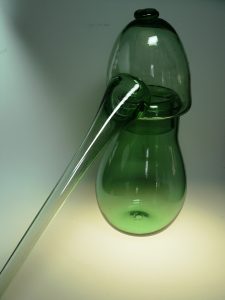Alembik – Deutsch/German

Die Vorzüge von Glas für medizinische, chemische und naturwissenschaftliche Zwecke waren bereits den antiken Alchimisten bekannt: Glas ist geruchlos, beständig gegen Säuren und Laugen, durchsichtig und leicht zu reinigen. Es sind genau diese Vorzüge, die Glas zum heute unentbehrlichen Werkstoff für Industrie, Technik und Medizin machen.
Der Alembik gehörte einst zu den wichtigsten Arbeitsmitteln der Alchimisten. Diese ersten „Chemiker“ beschäftigten sich mit der Herstellung von Gold beziehungsweise mit der Umwandlung unedler Metalle in Gold und Silber. Dafür suchten sie nach einer ganz bestimmten Tinktur, die sie „Stein der Weisen“ nannten. Heutige Chemiker würden dazu Katalysator sagen. Bei ihren diversen Umwandlungsversuchen waren Destillations-, Extraktions- und sonstige Apparaturen unumgängliche Hilfsmittel. Eine dieser Destillationsapparaturen war der „Alembik“, von arabisch „al-anbiq“, Gefäß oder Schale. Damit konnten Stoffe durch Erhitzen und anschließendes Abkühlen voneinander getrennt werden.
Die Erfindung des „Alembik“ wird den Arabern zugeschrieben. Sie verfeinerten das bereits in der Antike bekannte Verfahren der Destillation im 9. oder 10. Jahrhundert. Über den Destillierkolben mit der zu destillierenden Essenz setzten sie einen Helm, in dem sich innen eine Auffangrinne befand. Dort sammelte sich das Kondensat, bevor es aus dem seitlich angebrachten Rohr in ein Auffanggefäß abfloss. Ursprünglich verwendete man den Namen „Alembik“ nur für den Destillierhelm. Im Laufe der Jahre übertrug sich der Name auf die gesamte Apparatur: den Destillierkolben mit Destillierhelm und der Auffangflasche.
Alembik – English

Even alchemists from antiquity knew the advantages of glass for medicine, chemistry and the natural sciences: it is odourless, acid and alkali proof, transparent and easy to clean. And it is these properties that make glass an indispensable commodity for industry, technology and medicine today.
The Alembik was once one of an alchemist’s most important pieces of equipment. These early „chemists,“ were concerned with producing gold or transforming common metals into gold and silver. They were searching for a particular tincture, that they called „the philosopher’s stone.“ Today, chemists would refer to it as a catalyst. In their numerous transformation attempts distillation, extraction and other types of apparatus were essential tools. The „Alembik“, or „al-anbiq“, in Arabian, meaning receptacle or bowl, was one such distillation apparatus. Substances could be heated in it and then cooled and separated.
The invention of the „Alembik“ is attributed to the Arabs who refined the process of distillation, already used during antiquity, in the 9th or 10th century. They put a domed lid with an internal collection groove above the distillation flask containing the essence to be distilled where the condensate collected before it flowed out of a tube mounted on the side into a collection container. The name „Alembik“ was originally used to describe the distillation lid only, but over the years the name has come to refer to the whole piece of apparatus: the distillation flask, domed lid and collection bottle.